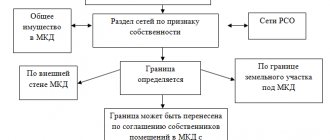Currently, for HOAs there is no question of who should maintain and repair in-house utility networks, including built-in heating units, water pumps, etc. As a general rule, the outer boundary of the electricity, heat, water supply and sewerage networks that are part of the common property is the outer boundary of the wall of an apartment building (clause 8 of the Rules for the maintenance of common property in MKD). The situation is different with engineering infrastructure located outside the walls of the house in the immediate vicinity of the apartment building and intended to serve the house (for example, pumping stations, heating points, transformer substations and corresponding networks to the walls of the house). Who should maintain and repair such infrastructure facilities? First of all, the HOA needs to find out whose property they are, since it is the owners who bear the burden of maintaining the property they own.
Goals and objectives of the act
The main purpose of this act is to clearly define the boundaries beyond which lies the area of responsibility of the resource supplying organization and the consumer. At the same time, in the legislation of the Russian Federation there is no unambiguous definition of the concept of “delimitation of balance sheet and operational responsibility”, and there are also no explanations as to how exactly it should occur.
You can more or less understand this only by carefully studying the regulatory documents.
The boundary of the balance sheet is considered to be the line that separates the general network from the network of a specific owner.
That is, for example, if we are talking about an apartment building, then there is a division of networks related to the list of common property and others.
Documentary differentiation is made by signing an appropriate agreement between the parties, as well as drawing up a special act. It happens that an agreement cannot be reached (as a rule, due to the fact that the resource supplier unreasonably expands the client’s area of responsibility) - in this case, the delimitation takes place in court.
So, based on the above, we can conclude that separation is necessary so that each party has an idea of who exactly services this or that section of communication networks, and also, in the event of establishing the fact of damage or wear and tear of the networks, can understand exactly who is responsible for its repair and restoration. In addition, the act becomes a point in the process of connecting newly built objects to communication networks.
If for some reason it is not possible to determine operational responsibility, a balance sheet is established - usually it corresponds to the line of the external wall of the building or structure.
By mutual agreement of the parties, other ways of determining boundaries are possible.
News of the Residential Complex "Peredelkino Blizhnoe"
15 July 2015 Dear residents!
In order to implement the Protocol of the meeting with the owners of residential premises of the city-park "Peredelkino Blizhnoe" with the management organization LLC "UK Comfort City", we publish the following information. The delimitation of areas of responsibility between the management organization and the owner of the premises is established by Decree of the Government of the Russian Federation dated August 13, 2006 No. 491 “On approval of the Rules for the maintenance of common property in an apartment building and the rules for changing the amount of payment for the maintenance and repair of residential premises in the case of the provision of services and performance of work on management, maintenance and repair of common property in an apartment building of inadequate quality and (or) with interruptions exceeding the established duration" (hereinafter referred to as Resolution No. 491).
In accordance with paragraph 5 of Decree No. 491, the areas of responsibility of the cold and hot water supply systems are demarcated. According to this paragraph, the common property includes in-house engineering systems of cold and hot water supply, consisting of risers, branches from the risers to the first disconnecting device located on the branches from the risers, the specified disconnecting devices, collective (common house) cold and hot water metering devices, the first shut-off and control valves on the branches of intra-apartment wiring from risers, as well as mechanical, electrical, sanitary and other equipment located on these networks.
In accordance with paragraph 5 of Resolution No. 491, the areas of responsibility of the management organization and the owner regarding the wastewater disposal system are regulated. According to this paragraph, the common property includes an in-house engineering drainage system, consisting of sewer outlets, fittings (including bends, transitions, pipes, revisions, crosses, tees), risers, plugs, exhaust pipes, drainage funnels, cleanings, branches from risers to the first butt joints, as well as other equipment located in this system.
In accordance with paragraph 6 of Resolution No. 491, the common property includes an intra-house heating system, consisting of risers, heating elements, control and shut-off valves, collective (common house) heat energy metering devices, as well as other equipment located on these networks.
It should be taken into account that, according to the position of the courts, the heating elements of the heating system (radiators) located in the apartments, located on branches from the risers of the intra-house heating system, serve only one apartment and can be dismantled by the owner after obtaining permission to renovate the residential premises. Thus, the responsibility for maintaining equipment serving only one specific premises falls under the responsibility of the premises owner.
According to clause 7 of Resolution No. 491, the common property includes an intra-house power supply system, consisting of incoming cabinets, input distribution devices, protection, monitoring and control equipment, collective (common house) electrical energy metering devices, floor panels and cabinets, lighting installations for premises general use, electrical installations of smoke removal systems, automatic fire alarm systems of internal fire water
Features of drawing up the act, general points
If you are tasked with creating an act of delimitation of balance sheet and operational responsibilities, and you have no idea how to do this correctly, we recommend that you carefully read the tips below. Check out the sample document as well - you will probably be able to create your own form based on it.
Today there is no single unified form of the act. This suggests that employees of resource supply companies have the opportunity to write it in any form or, if the organization has an approved document template, according to its type.
Regardless of which method of execution is chosen, when writing the act, it is necessary to take into account several common points characteristic of all such papers. For example, you need to ensure that the structure and content of the form meet certain office work standards.
In other words, the act should be divided into three parts:
- the so-called “header”, where data about the document itself is entered;
- main block - includes data about the supplier and consumer of services, address and some individual technical characteristics of the object, etc. Quite often, a graphically designed layout of communications is also included here (however, it can also be attached as a separate document);
- the conclusion is the fact of approval of the division of responsibility.
The act can be drawn up on an ordinary blank sheet of any convenient format (generally applicable A4), by hand or typed on a computer - these values do not play a role in determining its legality. The only important thing is that the act is drawn up without errors or omissions, and if any do occur, it is better not to correct them, but to draw up a new form.
In addition, the document must be endorsed using seals (provided that their use is enshrined in the company’s accounting policies).
The application is drawn up in three identical copies .
- One is sent to the service consumer,
- the second - to the controlling supervisory structure,
- the third one remains with the resource supplying organization.
The act must be signed by representatives of two parties: the resource supplier and the recipient.
Property or not?
The possibility of including external engineering infrastructure in the common property of the apartment building is indicated by sub-clause. “g” clause 2 of the Rules for the maintenance of common property in apartment buildings, according to which the common property, among other things, includes objects intended for the maintenance, operation and improvement of an apartment building, including transformer substations, heating points intended to serve one apartment building, collective parking lots , garages, children's and sports grounds located within the boundaries of the land plot on which the apartment building is located. First of all, let us pay attention to one mandatory condition for including external infrastructure objects in the general property of an apartment building: such an object must be served by only one apartment building . In other words, if a pumping station, heating point or transformer substation supplies water, heat or electricity to two or more houses, they cannot be the common property of any of them, much less the common property of several houses at the same time. This was first pointed out by the Presidium of the Supreme Arbitration Court of the Russian Federation (Resolution No. 14801/08 of December 15, 2009), recognizing that part of the heating networks through which heat is supplied to both a residential building and another building cannot be classified as common property owners of premises in MKD. And in its ruling dated August 2, 2012 No. VAS-9948/12, the Supreme Arbitration Court of the Russian Federation agreed that a water pump designed to serve more than one residential (non-residential) premises in several apartment buildings cannot be classified as a common one. property of the owners of the premises of a single apartment building. It’s another matter if the external infrastructure facility serves only one house. In this case, it can be included in the common property, but only if there are title documents , from which it follows that the apartment building is the owner of the corresponding structure. The courts have repeatedly pointed this out. In particular, 17 AAS, in resolution No. 17AP-18007/15 dated January 29, 2021, directly states that water supply and sewerage networks that provide not only an intra-house water supply and sewerage system, but also a system outside it cannot be included as part of the common property of citizens living in an apartment building in the absence of title documents. The Federal Antimonopoly Service of the Volga-Vyatka District (resolution of January 14, 2021 in case No. A43-1071/2015) recognized that, as a general rule (in the absence of evidence otherwise), networks located outside the external network of an apartment building are not the common property of the residents of this building and should not be serviced by them . In practice, as a rule, it is not possible to find documents that make it possible to recognize engineering infrastructure objects outside the walls of the house as the common property of the HOA, unless, of course, the owners of the apartment building premises have decided to include them in the common property. This is primarily due to the fact that such objects, in accordance with the resolution of the Supreme Council of the Russian Federation of December 27, 1991 N 3020-1 “On the division of state property in the Russian Federation into federal property, state property of republics within the Russian Federation, territories, regions, autonomous regions , autonomous okrugs, cities of Moscow and St. Petersburg and municipal property" are transferred to the municipal property of the cities (regardless of whose balance sheet they are on). This was also pointed out by the Supreme Arbitration Court of the Russian Federation, confirming that urban engineering infrastructure facilities are intended to resolve issues of local importance and, accordingly, belong to municipal property, while their absence in the list of municipal property objects cannot be the basis for assigning the responsibility for their maintenance to others persons (determination of the Supreme Arbitration Court of the Russian Federation dated December 12, 2013 N VAS-17112/13). Despite the above, in some cases, HOAs may have operational responsibility for utility infrastructure outside the walls of the building.
What is stated in the document
Of course, there are nuances in the design of the document in question, which are slightly different from the rules that apply to acts of other types. The paper specifies the following details:
- Layout of gas equipment;
- It is indicated who is responsible for this equipment;
- A list of the boundaries of the act is indicated;
- The personal data of each party is entered. In particular, the full name of the owners or their representative, passport details, etc.;
- List of places where gas equipment is connected to the common line;
- The scope of authority of each party is outlined with a schematic designation;
- Other nuances that each of the parties to the transaction will want to indicate.
Download: Act on delineating operational responsibilities of a gas pipeline
The paper must be drawn up for each of the parties, therefore at least three copies are provided. They are divided this way:
- One sample will remain with the subscriber;
- The second sample will go to the supplier company;
- The third sample will be stored in the archives of a government agency that is authorized to control the activities of enterprises.
The organization that supplies gas describes in the act not only a general list of networks, but a detailed list of equipment, the maintenance of which now falls on the shoulders of the management company or TZS. But in order not to confuse anything, the parties can use the services of professional contractors who will list the equipment as accurately as possible and what condition it is in.
How the act is drawn up
As already mentioned, the main purpose of this document is to distribute the responsibilities of the parties and protect the interests of each if any controversial issues arise.
The principle of operation is such that the client pays for the services of the company that provides them, and in return, the latter ensures that the client always has the required services in his home. Subscribers must maintain gas equipment in technically sound condition. This is necessary, because everyone understands how dangerous gas leaks are. If this happens, the whole house could explode. Therefore, when signing the act of operational responsibility of the gas pipeline, the party assigned these responsibilities must comply with them. And not because ignoring the rules will result in punishment, but because it is simply unsafe.
Dear readers!
Our articles talk about typical ways to resolve legal issues, but each case is unique. If you want to find out how to solve your specific problem, please contact the online consultant form on the right →
It's fast and free!
Or call us by phone (24/7):
If you want to find out how to solve your particular problem, call us by phone. It's fast and free!
+7 Moscow,
Moscow region
+7 Saint Petersburg,
Leningrad region
+7 Regions
(toll-free call for all regions of Russia)
As a rule, an agreement is concluded between organizations such as management companies or homeowners' associations and a resource supplying institution. The document is drawn up in the following order:
- At the first stage, you need to start preparing documentation. This list includes title documents for the building, although you can use a building permit or permission to put the house into operation.
- Next, the package of documents is sent to the supplier, who will review them and decide whether it is possible to conclude an agreement.
- After reviewing the documents and making a positive decision, an act is drawn up that describes in as much detail as possible all the features of this particular transaction.
- If the parties agree with the requirements described above and all the conditions suit them, the sample act is signed, and responsibility for part of the gas networks passes to the management company.
Difference from the certificate of operational ownership
The care and maintenance of gas networks is controlled not only by service providers, but also by the organization that assumes operational responsibility for this equipment. That’s why people have gas in their homes, which they pay for. The act of distinguishing between balance sheet and operational ownership is the documents that control these processes. But there is a difference between them:
- One indicates who owns the networks and installed gas equipment;
- The second demonstrates who is responsible for the proper operation of networks, their repair maintenance and other manipulations designed to maintain the operating condition of the equipment.
To make it easier to understand this distribution of responsibilities, here is an example. According to the balance sheet, the gas equipment belongs to the gas supply company, but the operational ownership indicates that it must be repaired by the management company of the house where this equipment is installed.
We establish the boundaries of utility networks according to the law.
When concluding an agreement with RSO.
The ideal option for the manager of an apartment building is to establish legal boundaries of operational responsibility when concluding an agreement with the RSO. But how can this be achieved if the RSO insists on different boundaries of responsibility? The manager should not rush to sign acts delineating operational responsibilities on illegal terms.
In accordance with civil law, a contract is considered concluded if an agreement is reached between the parties on all the essential terms of the contract. The legislator also included the condition on the limit of operational responsibility as an essential condition of the energy supply agreement. This condition is agreed upon by the parties by signing an act of delineation of operational responsibilities.
Consequently, if RSO proposes to conclude an agreement with an act of delimitation of operational responsibility, in which the boundaries go beyond the common property of the owners of premises in the apartment building, it is necessary to sign such an agreement with a protocol of disagreements regarding the boundaries of responsibility. In the protocol of disagreements, it is necessary to indicate the condition on the boundaries of operational responsibility with reference to clause 8 of the Rules for the maintenance of common property: the boundary of operational responsibility runs along the outer boundary of the wall of the apartment building (the boundary of the land plot that is in the common shared ownership of the owners of the premises in the house).
When considering disputes regarding the settlement of disagreements when concluding energy supply contracts, the courts approve such contracts in relation to the conditions on the boundaries of operational responsibility. Examples from practice include the decisions of the Supreme Court AS of November 19, 2015 in case No. A29-10092/2014, the ZSO AS of November 9, 2015 in case No. A75-1441/2015, the SKO AS of December 11, 2015 in case No. A25-953/2014 .
If network boundaries are not in the agreement with RSO .
If the parties did not go to court to resolve disagreements when concluding a resource supply agreement and the protocol of disagreements remained unsigned by the RSO, if disputes arise regarding the volumes of supplied resources and the limits of responsibility, the agreement will not be recognized by the court as not concluded, since the condition on the limits of operational responsibility can be regulated by law.
In Resolution of the Presidium of the Supreme Arbitration Court of the Russian Federation dated September 7, 2010 No. 3409/10, the court came to the conclusion that the absence of an act of delimitation of balance sheet ownership agreed upon by the parties cannot indicate that the parties did not conclude an agreement. In the absence of an act of delimitation of the operational responsibilities of the parties, the boundary of operational responsibility is established according to the balance sheet, and the latter is determined on the basis of ownership.
If the agreement with RNO establishes the boundaries of networks not according to the law.
As a rule, an agreement is concluded for a certain period and is considered extended on the same terms if neither party declares within a certain period of time its intention to conclude an agreement on new terms.
In the manner established by the resource supply agreement, the utility service provider has the right to declare termination of the agreement and the conclusion of a new agreement on different terms. In the new agreement, he will be able to achieve agreement on the boundaries in the wording he proposed (if necessary, in court).
Ownerless networks.
Quite often, utility networks are not the responsibility of any party to a resource supply agreement, that is, they are ownerless. Who is responsible for maintaining these networks and paying for losses of utility resources in them?
According to the current legislation, if a section of networks between the MKD networks and the DSO networks is ownerless, when setting the tariff for the DSO, the costs of maintaining, repairing and operating this section of the networks are taken into account. This is what it says:
in the Federal Law of July 27, 2010 No. 190-FZ “On Heat Supply” (Part 4, Article 8, Parts 5, 6, Article 15);
in the Federal Law of December 7, 2011 No. 416-FZ “On Water Supply and Sanitation” (Parts 5, 6, Article 8);
in the Federal Law of March 26, 2003 No. 35-FZ “On Electric Power Industry” (Part 4, Article 28).
It is illegal to blame consumers and providers of utility services for losses of utility resources in ownerless sections of networks. This conclusion regarding electricity losses was made in the Decision of the Supreme Arbitration Court of the Russian Federation dated October 28, 2013 No. VAS-10864/13.







